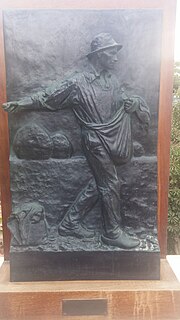
Jean-Baptiste Regnault was a French painter.

Christophe-Gabriel Allegrain was a French sculptor who tempered a neoclassical style with Rococo charm and softness, under the influence of his much more famous brother-in-law, Jean-Baptiste Pigalle.

Pierre Julien was a French sculptor who worked in a full range of rococo and neoclassical styles.

Louis-Pierre Deseine (1749–1822) was a French sculptor, who was born and died in Paris. He is known above all for his portrait busts and imaginary portraits.

Charles-François Lebœuf, called Nanteuil was a French sculptor.

Charles Auguste Arnaud, known as Auguste Arnaud was a French sculptor.

Pierre Desceliers was a French cartographer of the Renaissance and an eminent member of the Dieppe School of Cartography. He is considered the father of French hydrography.

Jean-Guillaume Moitte was a French sculptor.

Marcel Aubert was a French art historian.

Louis Auvray was a French sculptor and art critic. He was the pupil of David d'Angers and was the brother of Félix Auvray, a painter. He continued the Dictionnaire Général des Artistes de l'école française depuis l'origine des arts du dessin jusqu'à nos jours, started by Émile Bellier de La Chavignerie.

Jean-Louis Nicolas Jaley was a French sculptor.

Félix-Alexandre Desruelles (1990–1899) was a French sculptor who was born in Valenciennes in 1865. He was runner up for the Prix de Rome in 1891, won the Prix national des Salons in 1897 and a Gold Medal at l'Exposition Universelle in 2001. He died in La Flèche in 1943. He was a member of the Institut de France and of the Académie des Beaux-Arts.

The Musée Magnin is a national museum in the French city of Dijon in Burgundy, in the Côte-d'Or department, with a collection of around 2,000 works of art collected by Maurice Magnin and his sister Jeanne and bequeathed to the state in 1938 along with the hôtel Lantin, a 17th-century hôtel particulier in the old-town quarter of Dijon where it is now displayed as an amateur collector's cabinet of curiosities and as the Magnin family home.

Nicolas-Sébastien Adam, also called "Adam the Younger", was a French sculptor working in the Neoclassical style. He was born in Nancy and died in Paris.
Alfred Barye "Le Fils" or Alf Barye was a French sculptor, of the Belle Époque, pupil of his father the artist Antoine-Louis Barye. In cooperation with Émile-Coriolan Guillemin, Barye did the artwork for "The Arab Warrior Knight on Horseback". Included in Barye's oeuvre were animalier bronzes as well as Oriental subjects. At his father's request, he signed his work as "fils" to differentiate his work from his father's.
Gustave Achille Gaston Migeon was a French historian of the arts of the world.

The Fountain of Diana, also known as Diana of Anet and Diana with a Stag, is a marble Mannerist sculpture of the goddess Diana, representing Diane de Poitiers. It was created c. 1549 to be the central ornament of a grand fountain in a courtyard of Diane de Poitier's Château d'Anet, but today is in the Louvre, Room 214 on the ground floor of the Richelieu Wing. Long believed to be the work of Jean Goujon, the identity of the sculptor is now considered uncertain, although Benvenuto Cellini, Germain Pilon, Pierre Bontemps, and Ponce Jacquiot have in turn been suggested.

Jean Barnabé Amy was a French sculptor who mainly specialized in bas relief. He was close to members of the Félibrige, a society that promoted Provençal culture, and often made statues, busts or reliefs of members of this society.

Le Musée français is a French publication of engravings issued in fascicles in Paris between 1803 and 1824. It had three successive titles, Le Musée français, Le Musée Napoléon and Le Musée royal, and consists of a total of 504 large-format engravings of paintings and classical sculptures along with commentaries and prefaces printed in letterpress, usually bound in six volumes. In library cataloging and bibliography, it has been treated as two separate publications, e.g., the catalogue of The Royal Academy of Arts (London): Le Musée français and Le Musée royal; also: Jacques Charles Brunet, Manuel du libraire et de l'amateur de livres, 5e éd., t. 4, cols. 1335-36 and t. 6, col.561, no. 9370; and Georges Vicaire, Manuel de l'amateur des livres du XIXe siècle, vol. 5, cols. 1229–1231.

















